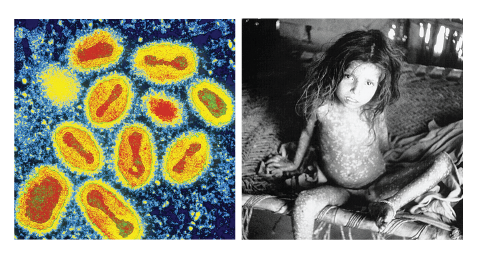
On May 17, 2010 in Geneva, a bronze statue of a child being vaccinated was unveiled to celebrate one of humanity’s great victories: the eradication of smallpox. In the words of the World Health Organization, 1980 was the year in which “the world and its peoples [had] won freedom from smallpox, a most devastating disease sweeping in epidemic form through many countries …, leaving death, blindness and disfigurement in its wake.” [1] Such a victory meant that no human born after 1980 would ever be a victim of this terrible virus, or carry the characteristic scars left by the smallpox vaccine. Indeed, 1977 saw in a Somali man the very last natural case of this disease.
What kind of tool allowed humans to deliberately target and extinguish an invisible threat that had afflicted more than half of humanity 50 years earlier? What is this power that enables our species to mold the world so permanently? If you came to this blog post out of your own volition, in the same way we, the writers, did, you must also be intrigued by these questions, and hopefully inspired by what you probably suspect the answer is: this incredibly powerful and stimulating human activity called science!

It is with science in mind that ScIU: Conversations in Science @ Indiana University has been created. Such conversations are an attempt to provide you with the opportunity to discover the diversity and reach of the scientific research conducted right here on your doorstep, at Indiana University, as well as a chance to dialogue with the vibrant scientific community behind it. (See our more detailed mission statement here.) But before our first foray into the world of science at IU, it could help to have a clear picture of our topic of conversation. So let us step back and ponder: What is science, really?
Although it might sound like a simple inquiry, determining the distinctive features of science is a daunting task that has troubled thinkers for centuries. Occasionally, however, when we do not know how to define something, nor to explain how it works, we nonetheless recognize it when we see it. So perhaps a good initial strategy for understanding the nature of science is to think of notable examples of scientific accomplishments.
Smallpox, for example, is only one of many serious human diseases that science has helped us control through vaccination; and vaccines are but one item in a long list of life-saving medical procedures (add to this: blood transfusions, organ transplantations, hemodialysis – the list goes on). Still other scientific concoctions make our lives easier and more comfortable: just consider painkillers, birth control pills and antihistamines.

But while biologists, chemists, and doctors have clearly been busy at their craft, so have other science professionals. Physicists and engineers have sent robotic rovers to our planetary neighbor Mars, as well as space probes for strolls near outer planets such as Uranus and Neptune. Their science also allowed the extraction of massive energy from the splitting of atoms – a feat that is at the same time awe-inspiring and terrifying (think atomic bomb!). This energy can then be harnessed and converted into electricity, and with a little help from another amazing contraption, the Internet, one can now do things that were unthinkable in the past, like Skyping with relatives on the other side of the globe.
So science is a human activity whose fruits surround us. Most, if not all, great discoveries that empowered humans in some way (for better or worse) have had their origin in the scientific effort. We sometimes use the term “applied science” to refer to the kind of scientific research that has real-world effects.
Yet science is also about describing nature, devising intricate mathematical formulas, and conducting laboratory experiments that could be deemed pointless at first glance. These practices, collectively referred to as “pure” or “basic science,” commonly have a more elusive utility, but their outcomes are absolutely critical to scientific progress. They are the nuts and bolts of science, necessary for its support as much as nuts and bolts are to works of civil engineering. The iconic silhouette of the Eiffel Tower would certainly be different were it not for the 2,500,000 rivets holding the monument together!
But while basic science has fruitfully underpinned applied science, providing us with the bits of knowledge we need to improve and revolutionize human life, it has also allowed us to practice unprecedented introspection by revealing many truths about ourselves and the universe around us. We now know, for example, that all life on Earth in its endless sizes, shapes and colors is descended from the same common ancestor that lived around 3.8 billion years ago. In fact, not only all life on our planet, but also all planets, the sun, and the other billions of star systems, are all made of cosmic dust – the atoms formed when the universe itself was born, approximately 13.7 billion years ago. In other words, basic science has taught us that our family is, in a way, as big as the universe itself. (But let us not get ahead of ourselves: more on these stories later!)

For now, I would like to welcome you to the ScIU blog! Here, my colleagues at ScIU and I will feature articles about the exciting science being done at Indiana University. And so, in keeping with this thing called “science,” I encourage you to keep an open, but skeptical, curious, yet rigorous mind.
Happy reading!
Reference
[1] World Health Organization. Global Commission for Certification of Smallpox Eradication. The Global Eradication of Smallpox: Final Report of the Global Commission for the Certification of Smallpox Eradication. Geneva: World Health Organization, 1980.
Edited by Clara Boothby

Leave a Reply